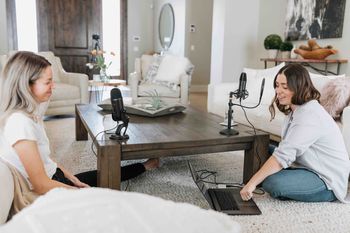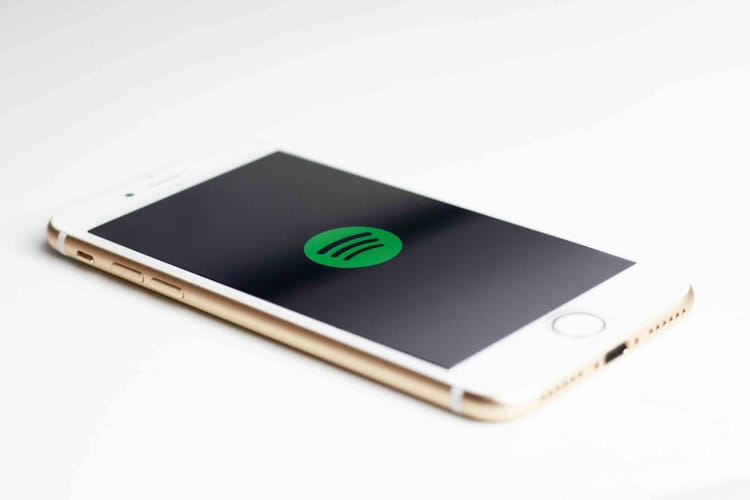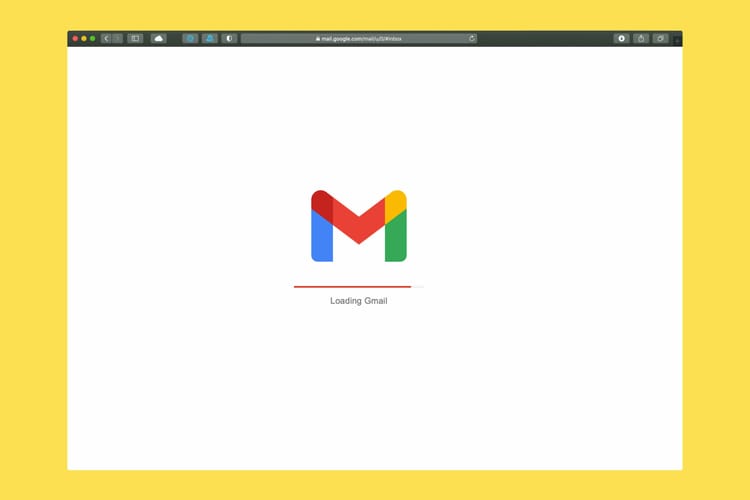It’s one thing to have a podcast. But it’s another to market it well.
As of September 2021, there were over 4 million different podcasts registered worldwide. It’s a staggering number to behold. That’s a lot of audio for listeners to choose from.
So the real question is, how do you get yours to stand out in a sea of noise?
If that’s the question on your mind, or you’re just feeling somewhat overwhelmed by the endless competition, don’t worry. We’ve pulled together 12 examples of effective podcast marketing strategies with advice on how you can implement them for your own show.

Book Your Next Podcast Guest the Easy Way
With more than 70,000 members, MatchMaker.fm is the largest online community connecting podcasters & guests.
Join MatchMaker todayIt's free to join!
12 Effective Podcast Marketing Strategies
There are many ways to market a podcast. But not every one will be right for you. Have a read through the below strategies and identify which ones will be a good fit for your show.
1. Market Your Podcast With Written Content
Transcribing your episodes is a great podcast marketing strategy. There’s a lot of value in doing so. And whilst at a first glance it can sound like a lot of effort, it’s actually pretty straightforward. All you need to do is give the reader a bit of context, write out the order in which things happened, and note down what was said by who. Simple.
There are many different reasons as to why this is beneficial. The main one being that it’s good podcast SEO practice. With any form of online content, the easiest way of reaching more people is to get it ranking on Google. And the easiest way to do that is through written copy. As far as Google’s concerned, the written word is still king. Failing to provide some form of written counterpart to your episodes means you completely miss out on a large pool of potential new listeners.
Another benefit of transcribing your show is that it makes it accessible to more people. For example, listening to a podcast when you’re hard of hearing isn’t an easy thing to do. Making your show available in other forms is a nice way of making your audience feel seen, considered and included.
Evo Terra, founder of Simpler Media and co-author of Podcasting for Dummies, highlighted the importance of transcribing your episodes in a LinkedIn post. He says:
People with vision loss and hearing loss have access to all sorts of tools and services to allow them to enjoy the same content that fully-sighted and full-hearing people enjoy. But they only work if you, the podcaster, do your part to include them in the party. Starting with your next episode, make a transcription available. Yes, of the entire episode.
Lastly, providing a transcript can also boost your download numbers, by allowing people to quickly check whether your episode contains the information they’re looking for. It’s very easy to skim a web page. It’s virtually impossible to skim a podcast episode. So you’re basically asking people to give you 30 minutes of their time with no guarantee of a return. If potential listeners can see what’s being discussed beforehand and they’re interested in it, they’ll probably take the time to go ahead and listen.
Example #1: Vox Creative - More Than This, “Immersive” Transcripts

Vox have created stunning “immersive” visual transcripts for all episodes of their podcast More Than This - which shares the stories of individuals who have transformed their creative hobbies into flourishing careers. Episode one features musician Mandy Harvey, her father Joe, and host Danielle Prescod. In both audio and written versions of the episode, we’re taken on a biographical journey of Mandy’s music career and personal struggles.
The first thing you’ll notice is the page’s impressive design. It’s hard not to. It’s not just a transcription of an episode, it’s a whole experience that’s bursting with colour, life and emotion. It doesn’t just look pretty either - it’s also ideal for SEO performance. That’s because it’s got clear subheadings, the copy has been carefully edited, and the reader can fully appreciate the natural flow of the podcast’s audio version.
Example #2: Evo Terra - Podcast Pontifications
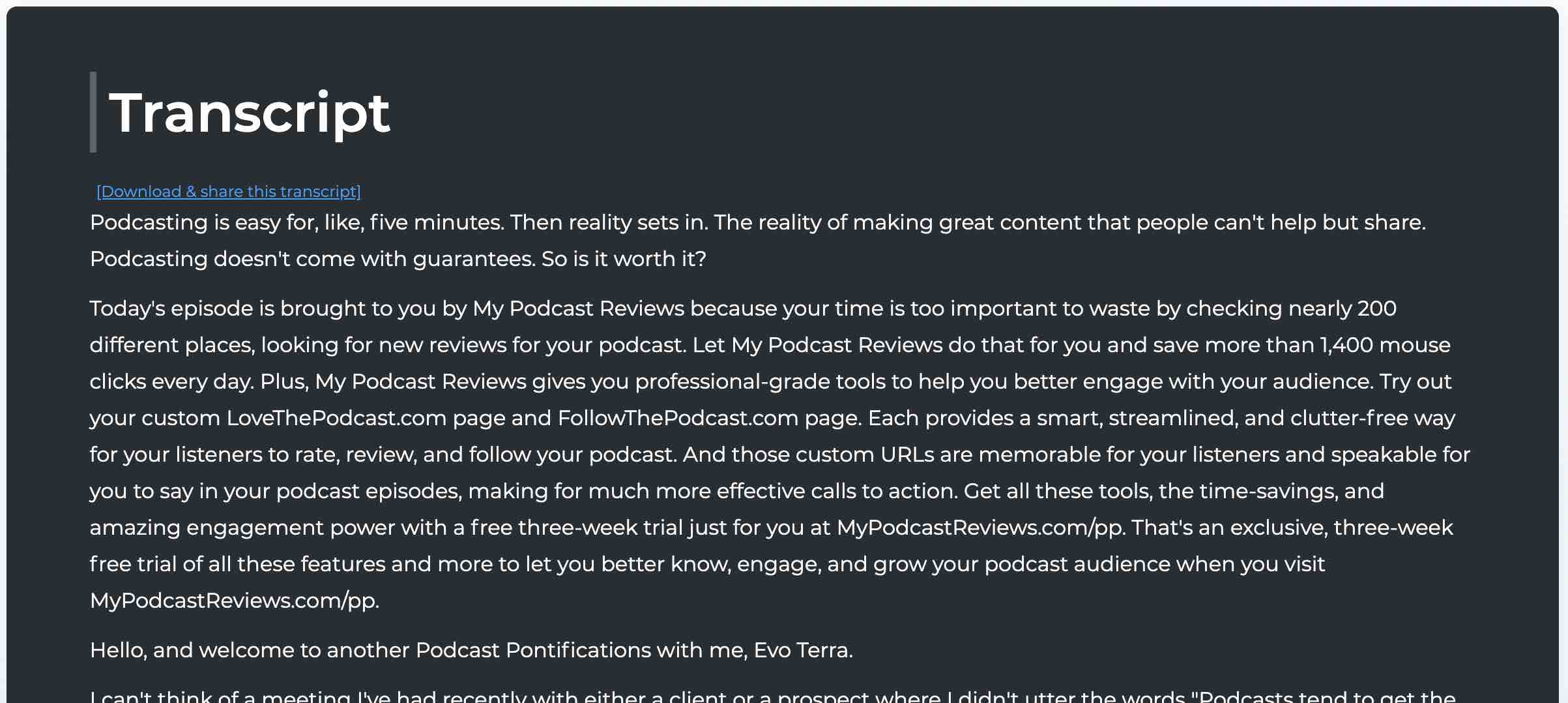
As impressive as Vox Creative’s example is, that level of formatting and design might not be possible for you. And that’s okay. The main thing is providing a transcript in the first place. To give you a more realistic example, have a look at the rest of Evo Terra’s below. It’s simple, straight to the point and gets the job done.
Evo Terra - Podcast Pontifications Transcription Example
2. Cross-Promote Your Show on Other Podcasts
Cross-promoting your show with other, like-minded podcasters is a great way to extend your reach.
If you’re not sure what cross-promotion is, it basically means partnering up with other podcast hosts to promote each other's shows. There are two ways of going about it - ad swaps and content collaborations.
Ad Swaps
You run an ad for their show on your podcast. And they do the same for you. Given the format, ads are best kept to 30 - 60 seconds in length. You can either prepare a script for the other host to read on their show, or let them ad lib a promotion for your show - it’s up to you.
Ad swaps provide a guarantee that the person listening is already a podcast fan. Plus, you’ll know that they’re already on their preferred platform, and they know how to use it. The less effort it takes to find your show, the better.
Make sure that the person who you choose to collaborate with is relevant to your podcast too. If you’re a show that talks about sports, your audience probably isn’t going to be interested in hearing about linguistics. Drawing a link between your show and theirs is vital.
Content Collaboration
Content collaboration is a bit different. It’s more involved than ad swapping is, but the reward tends to be bigger. This is where you interview another podcaster on your show, and they interview you on theirs. It gives audiences a chance to get to know you better - if they like what they hear, they might be willing to subscribe.
You’ll need to be a bit more selective with who you partner up with for this. Consider which audiences are likely to be interested in your show, and focus your aim there. If you get it right, it’s an opportunity to grow your brand. Here are a few other things to think about when choosing your partner:
- Are they a good fit for your audience?
- Does it make sense for this podcaster to be on your show?
- Will your listeners genuinely be interested in what this person has to say?
- Do your audiences have things in common?

Find Cross-Promotion Partners the Easy Way
With more than 70,000 members, MatchMaker.fm is the largest online community connecting podcasters & guests.
Join MatchMaker todayIt's free to join!
3. Create QR Codes for People to Scan
These days, scanning a QR code to order a drink isn’t unusual at all. In fact, these little barcodes seem to be everywhere at the moment - bus tickets, menus, info points at museums, you name it. It’s no different for podcasts.
The main advantage of QR codes is that they’re super-flexible. They can be downloaded and scanned from any smartphone or device with a camera, as long as the barcode is in good condition. You don’t even have to have any special equipment to set one up. All you’ll need to do is generate it, print it, and distribute it.
QR codes are also cheap. Even if you don’t have heaps of money to blow on a big billboard advertising campaign, this can still be an effective podcast marketing strategy. Traditional flyers can be effective, but you can get creative here. For example, QR code beer coasters would be relatively cheap to make and they're much less likely to be thrown away. Once up and running, you’ll be able to see how many scans your barcode has had, as well as how many people have used it to access your show.
All in all, it gives you a golden opportunity to learn more about your audience. And by keeping track of your QR campaign data, it’ll be much easier to identify trends in new listener acquisition. The best part is that anyone can set up a QR code. Have a look at the generator tool below to see just how simple it is.
How to Create a QR Code for Your Podcast
Example: We Were Always Here by Broccoli Productions
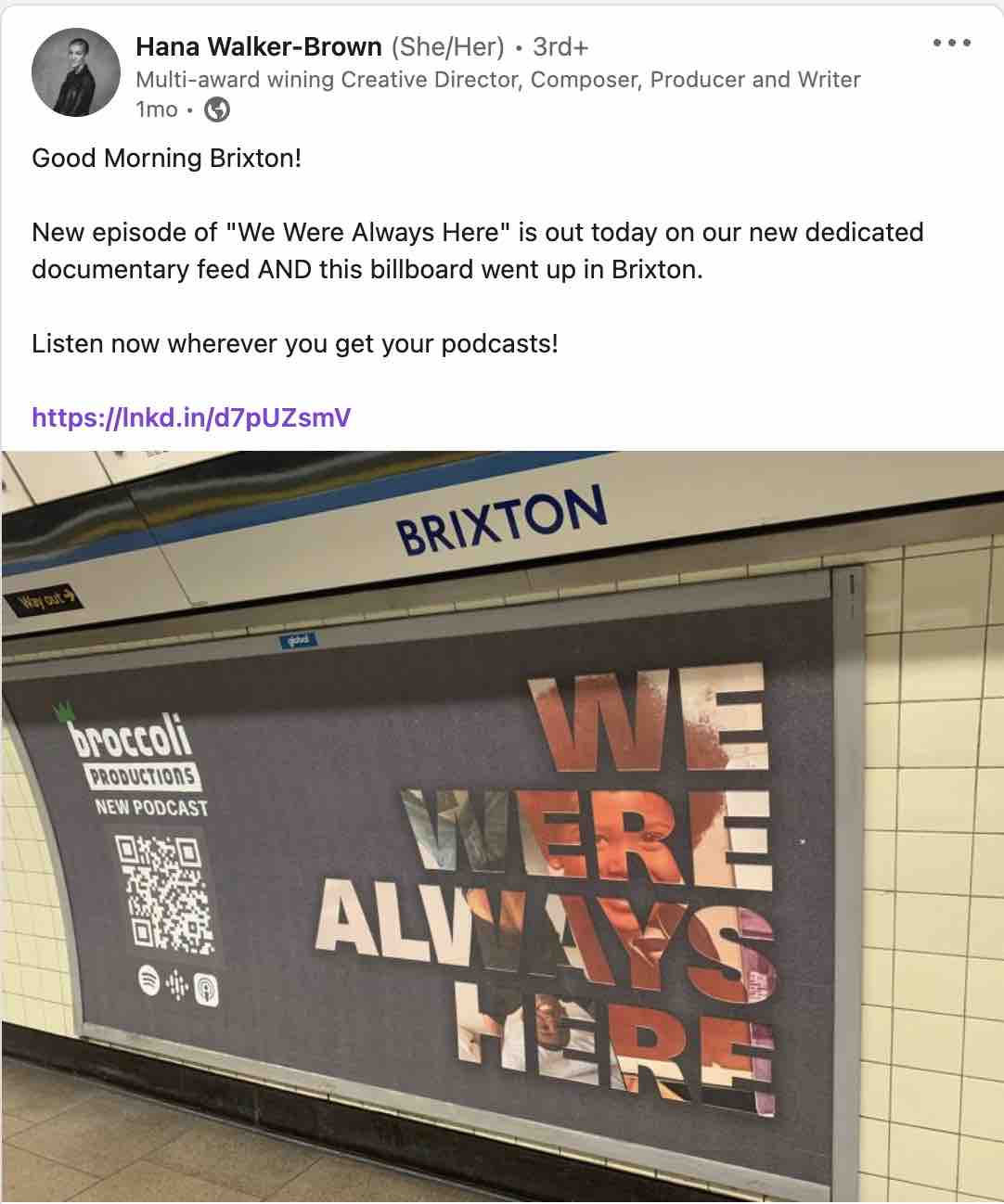
We Were Always Here by Broccoli Productions recently ran an advertising campaign on the London Underground, where a poster of the show’s cover art was accompanied by a QR code. All people had to do was scan it on their smartphones as they walked past. Genius.
4. Create / Optimise Your Website & Start a Mailing List
Having a website that listeners can find you on is good podcast marketing. If done well, it can act as a hub for your show. This is important if you’re wanting to build on your brand, and as touched on above, it’s a must if you’re trying to level up your SEO.
If you can, create a mailing list too. This is so you can send your audience a newsletter on a regular basis. Newsletters are a fantastic way of keeping listeners engaged and interested in your show, as well as letting them know what’s coming up.
Example: The Huberman Lab
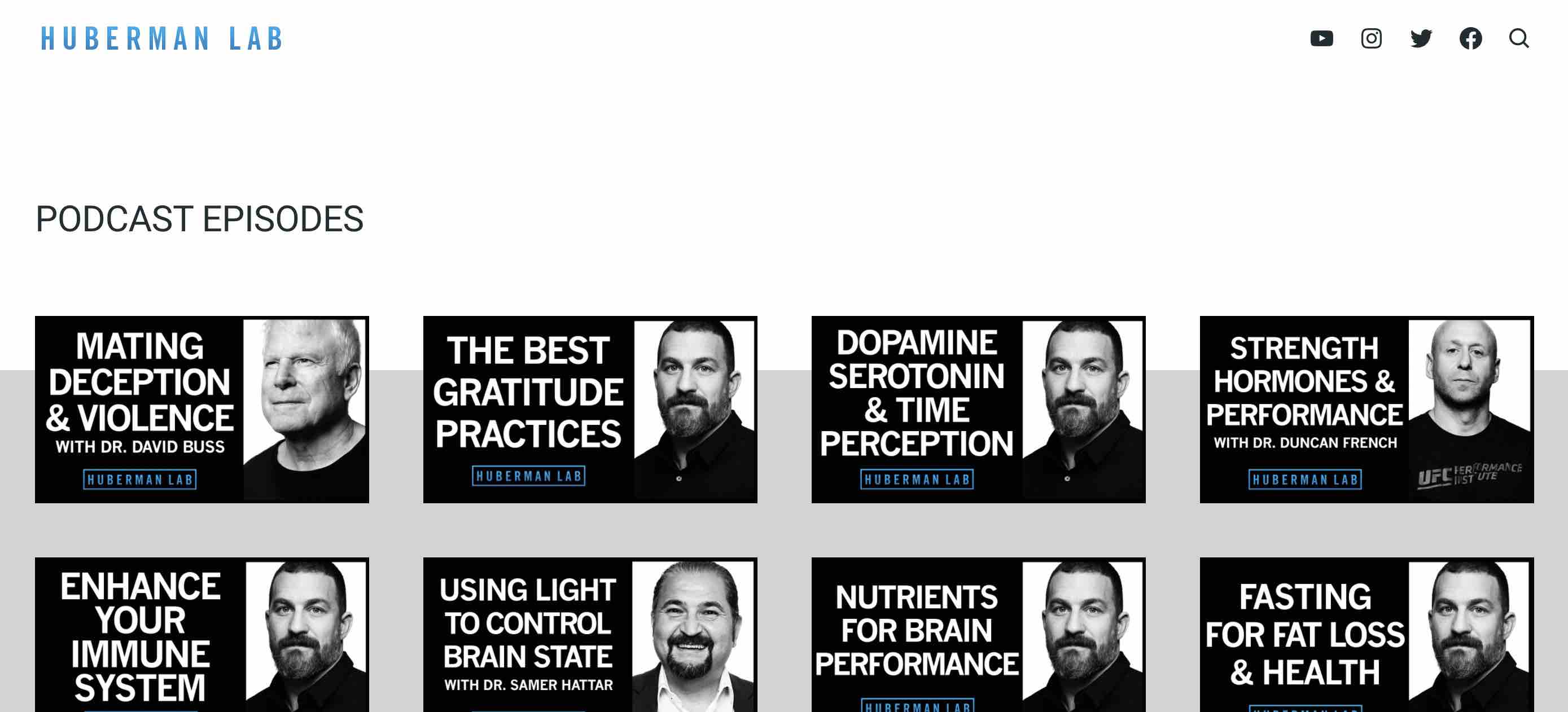
The Huberman Lab is hosted by Dr. Andrew Huberman, a leading ophthalmologist and science communicator from Stanford University. The show focuses on neuroscience, human behaviour, and the central nervous system.
Huberman’s website for his podcast is a good example of how easy it needs to be. It’s simple to use, has everything you need, and is well sign-posted. It’s also the first search result that appears when you type the podcast’s name into Google. Bingo.
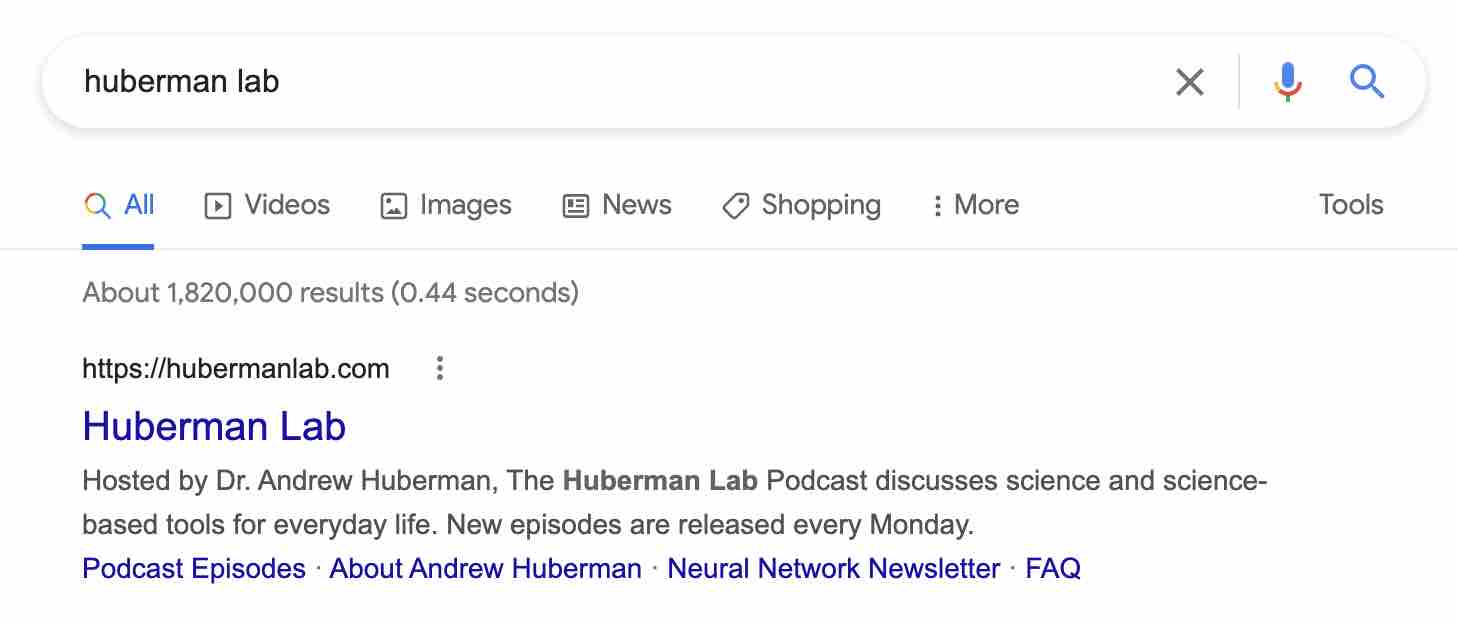
The website gives you essential information about the show, easy access to all episodes, a prominent CTA to sign up for the Neural Network Newsletter, as well as links to his social media platforms. When building your own podcast website, this is a great template to follow.
5. Take Your Podcast on Live Tours
If you’ve already got a dedicated fan base for your podcast (big or small), it might be time to take it on the road. Taking your show on tour is not only a nice thing to do, but it’s also a great way to engage with your audience and bring the conversation directly to them. You’ll also get a different bunch of people each evening, giving you the opportunity to regularly connect with new listeners.
Now, we’re not saying you should be hiring out arenas and selling out every seat. If you’ve got the means to do that, by all means do it. But if you’re a smaller show, going on tour isn’t impossible. You’ll still have to have a bit of spare cash to get yourself around, but there are loads of smaller venues that don’t cost the earth to hire.
Last year, Hishem Azzouz, founder of Azzouz Branding and host of The Recruitment Mentors Podcast, spoke to Podcast.co about hosting his first live event. This is what he had to say about it:
I always loved the idea of getting the people who listened to my podcast together in a room. Online interactions are great, but you can’t beat looking another person in the eye and having a real conversation.
He went on to talk about the logistics of hosting live events.
The first thing I did was float the idea to my LinkedIn network to gauge interest first. Before I committed to anything, I wanted to test the water and check the demand was actually there. The ticket cost was purely to cover the cost of the venue hire.
Example: My Favorite Murder
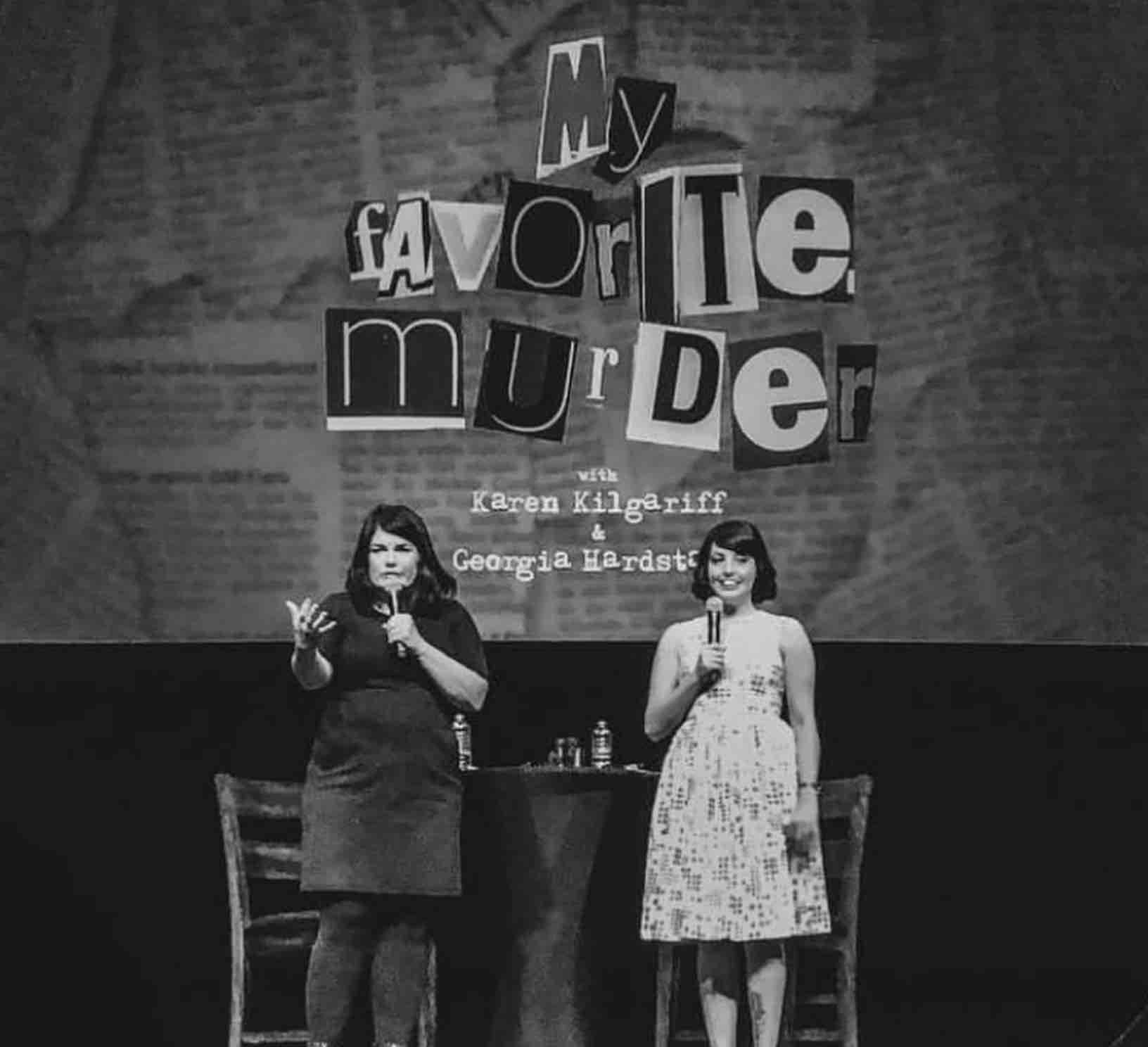
Karen Kilgariff and Georgia Hardstark combine true crime and comedy in their podcast, My Favorite Murder. Since its first episode in 2016, it’s been a regular top 10 in the iTunes comedy podcast charts, and now hits 35 million downloads per month. They’ve built up a die-hard fan base over the years, with their listeners calling themselves “Murderinos”.
Touring has played a key part in building Karen and Georgia’s relationship with their audience. Even when the show first launched, they attended podcast festivals before moving on to small theatres. The structure of their shows is simple, they cover a different case file each evening. It’s a strategy that, of course, brings risk. They’re not relying on rehearsed scripts that can last the whole leg of the tour. It’s different content at every show, providing audiences with an experience that they know is unique to them.
6. Effective Podcast Marketing on Social Media
Giving listeners a taste of what’s to come leaves them wanting more. Whether you prefer using Twitter, Instagram, Facebook or LinkedIn, it’s always worth posting a teaser of your new episode onto your feeds. Here’s why:
Firstly, anyone can make a social media account, meaning it’s free and easy to do.
Secondly, if you know your audience well, you’ll know what they’re looking for in each episode. If you can pull out a clip that you know they’ll be interested in, they’ll want more. Grabbing their attention before the episode has even been released creates anticipation.
Audio and video snippets are proven to give better conversion rates than still images. Keep your clip short though, you don’t want to lay it all out on the table too early on.
Example: The True Geordie Podcast

If there’s one thing that Brian Davis, host of True Geordie, knows, it’s that uploading clips onto social media is valuable. It’s how he got his start in the podcast industry. Brian’s first video was a 5-minute clip of him ranting about Newcastle United’s Nile Ranger. The rest is history. The clip went viral, he started uploading more, gained a loyal following and released a hit podcast off the back of his social media success.
Brian’s video was raw and honest, but most importantly, it left people wanting more. Now, whenever there’s a new episode coming out, it’s always teased on his social media first. Doing this tells fans what they can expect to see soon, creating an almost “you heard it before anyone else” dynamic. It strengthens the host-to-listener relationship, building trust and loyalty.
How to Promote Your Podcast on Social Media (12 Expert Tips)
7. Create a Podcast Trailer
Having a podcast trailer for your show is important for promotion. It should be quick and to the point, giving potential listeners a quick summary of your show with a taste of what’s to come. Think of it as an elevator pitch.
You should ideally drop the trailer about a week before your podcast release date. That gives you time to build up a bit of interest, and get people ready for the first episode to drop. Even after your show has launched, your trailer still has value. For example, Spotify feature trailers prominently within their various feeds, meaning lots of new listeners will see it when they first discover your show.
8. Create a Podcast Media Kit
Think of your media kit as a "shop window" for your podcast.
If you want to promote your podcast to journalists or local media outlets, a media kit is essential. They've become the standard currency in this part of the industry. Not only do they look more professional than just listing links in an email, but they’re also much easier and quicker for the journalist to digest. Which means you're more likely to be featured in their publication or get a reply.
How to Create an Impressive Podcast Media Kit (+ Examples)
9. Make Merch for Your Listeners
If you’ve got a good relationship with your audience, creating merch is good podcast marketing. This won’t be right for everyone though, it takes a lot of work to build a strong connection with listeners. Don’t be dispirited if you’re not quite there yet.
Getting audiences to sport your commodities around town is basically free promo for your show. Whether they’ve walked into a coffee shop with a sticker on their laptop, or worn your shirt to the supermarket, it’s brilliant for spreading the word. And, if someone then looks you up off the back of it, it’s a winner.
Example: Mimosa Sisterhood
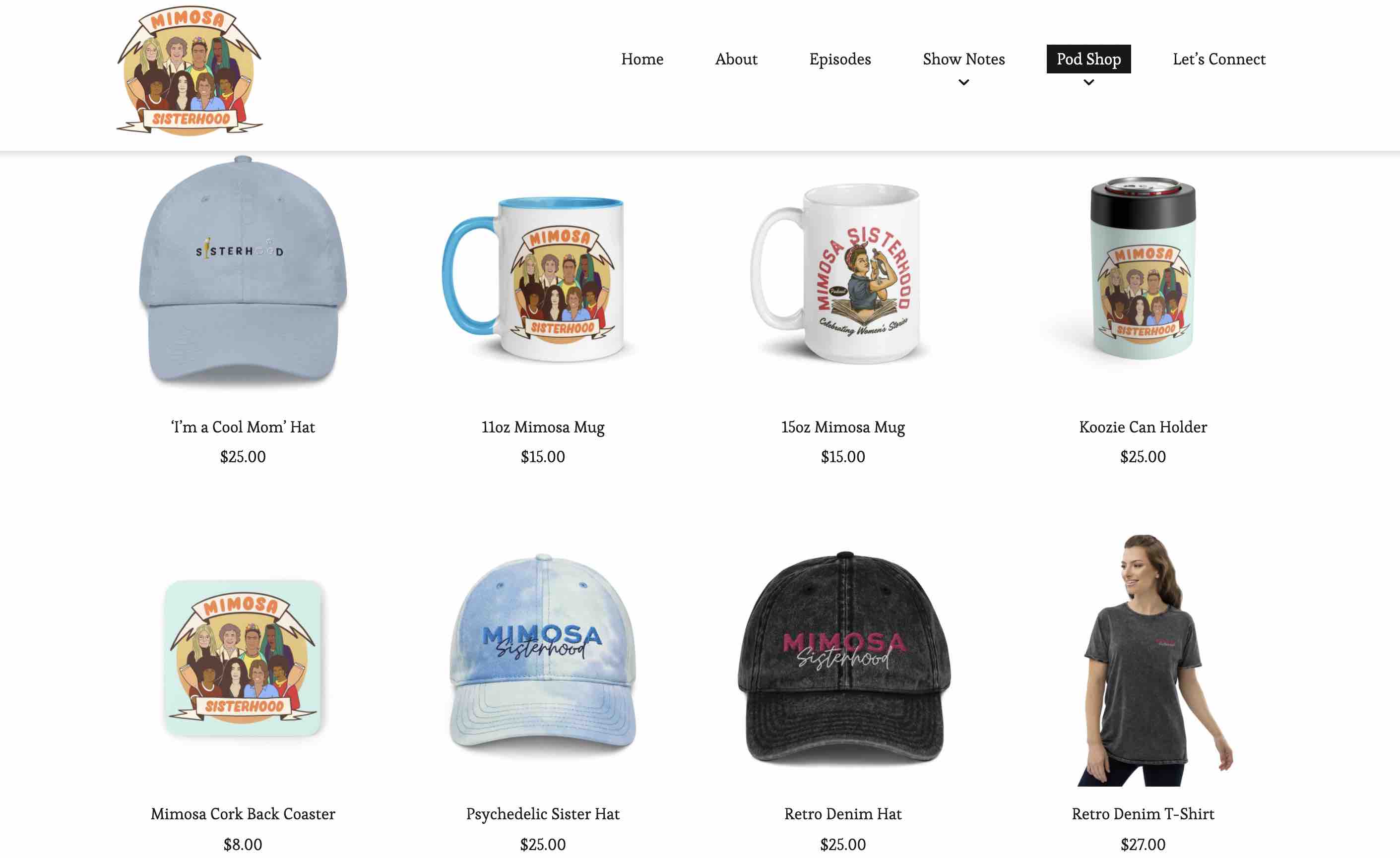
The Mimosa Sisterhood does merch well. With everything from stickers to hats, to mugs to pillows, there’s a wide variety of products to choose from. Check out the Mimosa Sisterhood shop below for inspiration.
If some listeners buy your merch and tag you on social media, you should always try to respond. It shows gratitude. It could be in the form of a direct message, a like or an add to your story. Mimosa Sisterhood does this really well, always engaging with their audience and creating a community-like vibe.
10. Run Giveaways on Social Media
Social media giveaways can be a powerful way of connecting with your audience, and increasing your reach. By offering listeners a chance to win a prize (such as a free subscription, merchandise, or exclusive content), podcasts can incentivize engagement and generate a buzz.
The method you use for this is up to you. You might decide to create a Facebook post or an Instagram Reel, for example. Either way, remember to ask your audience to share it to their own feeds and tag their friends. This will help spread the word about your podcast to new, potential listeners.
Additionally, giveaways can help podcasts build a sense of community amongst listeners, and loyalty towards the podcast. Think carefully about what you’re actually giving away, though. Keep it relevant, and make it make sense. We wouldn’t recommend an Amazon gift card, for example, as you’ll probably receive entries from people with no interest in your actual content or show.
11. Ask Listeners to Recommend Your Podcast to Their Friends
This one’s easy. But highly effective.
As a podcast host, you should never underestimate the power of word-of-mouth recommendations. What we mean by this, is to simply ask your audience to tell a friend, colleague or family member about your show. Don’t pressure your listeners, though. If you over-do it with multiple pleas per episode, you’ll just annoy them.
Instead, a quick nudge at the end of each episode will suffice. The Knowledge Project with Shane Parrish offers a good example of this. Here’s how he typically closes the last few seconds of each episode:
Can you do me a small favour? Go online right now and share this episode with one friend, who you think will love it.
12. Attend Relevant Meetups & Events
Going to conferences, meet-ups, and local events related to your podcast’s topic gives you an opportunity to raise your profile and chat to people about your show. You could even ask other attendees for some feedback, or episode ideas.
Be prepared, too. It’s a good idea to take business cards (or beer coasters) to any in-person events. You can hand these out to individuals you speak to, and leave a few dotted around the venue for others to pick up.
For details on events happening near you, checking your local newspapers or favoured online communities is a great place to start. Podcasting blog, Buzzsprout, have also put together a list of the best podcast conferences to attend in 2023 - which you can see here.

The #1 Podcasting Community
With more than 70,000 members, MatchMaker.fm is the largest online community connecting podcasters & guests.
Join MatchMaker todayIt's free to join!



